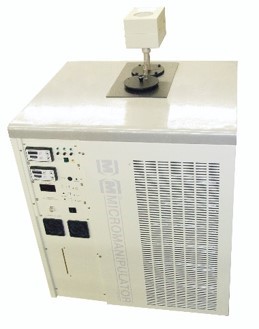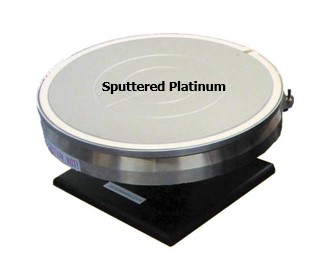H1000 Thermal System
-65° to 400°C
Configurations
- Coaxial
- Triaxial
- High Power
- Ambient to 400°C
- 0° to 400° C
- -65° to 400° C
- Probe station or stand alone
- Host programmable
Uniformity (Degree C)
- Min temp to -15 deg and 250C to max: +/- 2.5%
- -15 to +50 degree: +/- 1.0%
- 50 to 250 degree: +/- 1.5%
- 10 calibration points across temperature range
Isolation
Ambient- Surface to ground: Triax: >5T ohm, Coax: >100G ohm
- Surface to guard: Triax: >5T ohm, Coax: N/A
- Guard to ground: Triax: >5T ohm, Coax: N/A
- Surface to ground: Triax: >10G ohm, Coax: >1G ohm
- Surface to guard: Triax: >5G ohm, Coax: N/A
- Guard to ground: Triax: >5G ohm, Coax: N/A

Sputter Platinum Chuck Surface
- Sputtering is a process whereby atoms are ejected from a solid target material due to bombardment of the target by energetic particles.
- Thermal expansion isn’t an issue because the sputtered surface mimic’s the base material.
- 2x stronger bond than traditional plating.
- 2x more planar than traditional plating.
- The sputtered platinum surface provides superior electrical conductivity to sample backsides.
Vertical Expansion
- < 10 μm per 100 degree C
Why Micromanipulator?
- Best planarity at temperature
- Sputter platinum surface
- Best isolation at temperature
- Field upgradeable configurations
- Fast ramp rates
- Cooled radiator improves safety and stage integration
- Most available configurations—choose what you need now, upgrade later
- The H1000 is a proven platform—Micromanipulator has been manufacturing thermal chuck systems for more than 40-years
The combination of our specialized sputtering, radiator and trade secret designs provide the finest thermal systems available
Cooled Radiator

Micromanipulator planarity performance

Competitor planarity performance

| Thermal Range | 200mm: -65C/0C/Ambient to +400C | 300mm: -55C/0C/Ambient to 300C |
| Isolation | Ambient Surface to ground: Triax: >5T ohm, Coax: >100G ohm Surface to guard: Triax: >5T ohm, Coax: N/A Guard to ground: Triax: >5T ohm, Coax: N/A |
Max Temp Surface to ground: Triax: >10G ohm, Coax: >1G ohm Surface to guard: Triax: >5G ohm, Coax: N/A Guard to ground: Triax: >5G ohm, Coax: N/A |
| Time to Temp | 200mm (to 400 degree C) < 45 min (AC/DC) | 300mm (to 300 degree C) < 45 min (AC) 55 min (DC) |
| Configurations | Coaxial/Triaxial, AC or DC drives | |
| Cooling media | Air + fluid above ambient, fluid below ambient | |
| Resolution | 0.1 degree C. | |
| Stability °C | +/- 0.3 above 50 degree, +/- 1 degree within 5 degree of ambient. | |
| Uniformity °C |
Min temp to -15 deg and 250C to max: +/- 2.5% -15 to +50 degree: +/- 1.0% 50 to 250 degree: +/- 1.5% |
|
| Vertical Expansion | < 10 μm per 100 degree C | |
| Surface flatness + planarity on prober | +/- 5 μm (ambient) , < +/- 12.5 μm throughout temp range | |
H1000 Thermal Controller

HC1000 DC thermal controller
400° C to –65°C

Specialized radiator & planarity built into every chuck

| Feature | Description | Benefit |
| Active Mount Cooling | Cooled radiator | The radiator prevents chuck heat from transmitting to sensitive probe station elements like the wafer stage drive. Promotes safe operation for operators. |
| Planarity Contro | Kinematic | An important consideration because our customers expect the thermal chuck surface to remain planar, not just at ambient, but at temperature as well. Furthermore, our customers expect the planarity to be repeatable over time or repeated temperature cycles, for example, when transitioning from ambient, to 150C, and back to ambient. |
| Surface Contact Materia | Sputtered Platinum | The sputter process provides superior durability compared to plating (plating is OK for ambient chucks but presents problems for thermal chucks with expansion and contraction). Platinum provides excellent conductivity to substrate. |
| Surface Base Material | Ceramic | The ceramic surface (with triaxial versions) provides superior electrical isolation compared to competitive offerings, especially at higher temperatures. High isolation is important for the best low noise measurement performance. |
| Plumbing Integration | Direct stage integration | Micromanipulator installs integrated thermal chuck plumbing during manufacturing for future “plug and play” thermal chuck upgrades, but also to make certain the plumbing does not interfere with or restrict the positioning performance of the wafer stage. |
| Temperature Control | PID | PID control is a control loop feedback mechanism that ensures very fast temperature cycling times with minimal overshoot. This allows the thermal chuck to reach temperature quickly, which means you can start your tests sooner. |

